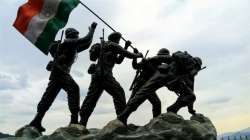July 26, 1999, the day India won the Kargil war against the joint forces of the Pakistani Army and the cross-border militia. It was a day of great triumph, a victory that had been achieved through blood, sweat and tears. It was also a day of great loss as the Indian Army suffered heavy casualties to take back what belonged to India - the Kargil Heights.
Let's go back memory lane and relive a story of great valour, a story of great sacrifice, a story of great triumph.
BACKGROUND of OP VIJAY
It was around the beginning of May that the Indian Army started receiving information that the peaks on the Kargil heights, that were left vacated by the Indian Army during the winters had been captured by the Pakistanis.
The Army think tank was still not sure though whether these infiltrators were from the Pakistani Army or the state-sponsored terrorists that were developing a hold across the LOC. Soon the Indian patrol parties started encountering stern resistance by these infiltrators.
A patrol party a few days later led by Captain Saurabh Kalia faced one such situation where the 5 Indian soldiers including Captain Kalia himself were captured by the Pak infiltrators and tortured to death.
It was soon clear that the infiltrators were indeed from the Pakistani Army because of the heavy artillery shelling from the Pakistani side. The shells fell on Indian civilian villages and there was loss of life.
Indian Army also found out that the infiltration was not just limited to the Kargil sector but spread across the Drass and Kaksar sector all the way till Mushkoh Valley. The situation was more serious than was thought to be and so the decision was taken to mobilise the army units to Kargil.
Troops were pulled out of the Kashmir Valley and from other parts of the country to reinforce the once already posted in the areas around Kargil.
Operation Vijay was launched.
Indian Army
The IAF also launched operation against the infiltrators but these operations were called off because of the positions of the Pak Army and their firepower resulting in IAF casualties and loss of two MiG fighter planes.
The Pakistani forces were now sitting at a position from where they could target the NH-1 which was India's main route connecting Srinagar and Leh. All Army convoys had to take this route to move from one place to another. And the Pakistani's took advantage of this. They started shelling the National Highway 1 and most of the movement had to get called off.
The Indian Army then launched infantry operations to take back the territory little by little, peak by peak.
Heavy gunfights took place across the Kargil, Drass, Kaksar and Mushkoh sectors. Pakistani's were sitting at the top and had the advantage, they had the supplies, they had the rations, they had the ammunition. The Indian Army had to assess enemy strengths and weakness and come up with a plan. Which they did eventually.
The infamous Bofors gun became one of the most important factors of Indian offence. The Bofors became the rearguard and bombarded the enemy posts. This rattled the Pak army and this was the shock and awe moment the Indian Army needed.
The Bofors Gun
The war lasted almost 3 months and in the end, the Indian Army pushed back the Pakistani army and other infiltrators.
The victory came at a massive cost though because the Indian Army took heavy casualty in the process. Many of the brave officers and men laid down their lives to see the tricolour waving over the Kargil sector.
The Heroes of Kargil
Every soldier that fought the war was a hero in his own right. The soldiers came up against overwhelming odds and unhindering opposition.
But there were some to whom the country owes a debt. The debt that could never be repaid. There were unparalleled instances of bravery from across the regiments. Some whose names you will never hear. But they were there when it mattered the most.
There were 4 sons of the soil who got the Param Vir Chakra
Captain Vikram Batra of the 13 Jammu and Kashmir Rifles was tasked at capturing point 5140. His nickname was Sher Shah and he was victory cry was 'Ye Dil Mange More'. He led a fierce attack against overwhelming odds and was martyred which capturing point 5140. By then he had ensured that his mission was accomplished.
Captain Vikram Batra PVC
Captain Manoj Panday of the 1/11 Gorkha Rifles was involved in several attacks along the Kargil front. He was tasked at clearing Jubar Top which was a very strategic point of the war. He showed immense bravery in making sure the Gorkha battalion captured the peak. He killed 2 enemies in hand combat before succumbing to the bullet wounds.
Naik Subedar Yogendra Singh Yadav of the 18 Grenadiers regiment. His platoon was part of the Ghatak commando tasked to capture three bunkers on Tiger Hill. On the morning of 4th July 1999 at the height of 16,500 feet, the platoon was to reach the top of a snow-covered cliff. In the final attack, he took many injuries but accomplished his task. He was one of the rare living PVC winners.
Rifleman Sanjay Kumar of the 13 Jammu and Kashmir Rifles, he was in the same regiment as Captain Vikram Batra. He was awarded PVC, for showing unusual display of grit, gallantry and determination in the face of enemy attack. While leading a team as a scout he was given the task of capturing Area Flat Top on 4th July 1999. He managed to kill three soldiers in hand combat and others in a second bunker by firing on them with a machine gun. His act of bravery inspired his platoon, to capture Area Flat top.
Also Read | 'Kargil Vijay Diwas' 20th anniv celebrations: 'Victory Flame' to be taken from Delhi to Dras
Latest India News
